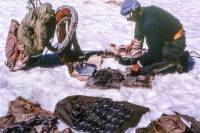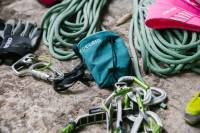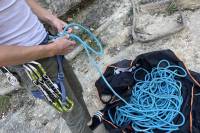https://s3.amazonaws.com/images.gearjunkie.com/uploads/2016/09/beckey-gear-laid-out-200×133.jpg
How are climbing ropes made? What can they do? (Answer: incredible things.) How do they do it? GearJunkie digs in, video essay style.
As climbers, we routinely stake our lives on a few nylon fibers and seldom give it a thought beyond that.
Did you know that the machines that make climbing ropes use up to 48 different spools of material at once? What about that each meter of an Edelrid rope passes through human hands before it leaves the factory floor?
We didn’t know either, to be honest. We were always more wrapped up in what we (and especially other, bolder adventurers) could do with them.
Read on for an expository ode to climbing ropes, made possible by the Edelrid factory team and buoyed by cameos from the sport’s best.
But first, a whipper compilation.
(Skip to about 40 seconds in to watch GearJunkie correspondent Christian Black rip gear out of Indian Creek’s infamous “Fingers in a Light Socket” while riding a 40-foot fall.)
Natural Fear: Early Plant-Based Ropes
In the early days, “climbing ropes” were basically boat ropes. Braided cords of plant-based material were the norm.
Hemp was a common fiber choice, and climbers relied on hemp ropes as late as the 1950s. The plant is suitably robust (in tensile strength), but it’s cumbersome compared to modern rope materials and doesn’t stretch much. Its resistance to stretching limits its strength.
Almost all available evidence indicates risk tolerance was very different back in the day. Helmy and Fred Beckey’s second ascent of the South Face of Mt. Waddington (still a serious route today) in 1942 would undoubtedly have utilized hemp ropes.
Antique Gear List: Climbers In 1942 Were Tougher Than Nails
Royal Robbins probably used hemp ropes on the first 5.9 in America, “Open Book,” in 1952. Climbers had first aided the route using wooden chocks (yes, 2x4s) the year before.
Robbins didn’t take any falls on the route, but similar ropes and gear held falls. Ignore the wannabe Ken Burns narration in this clip and hang with it for the first 20 seconds to watch a bonafide boat rope whipper.
Nylon Ropes Change the Game
In 1935, DuPont patented nylon, or synthetic polyamide, and changed the climbing world forever. The new fiber was mega-strong, stretchy, and lightweight — perfect for protecting climbers on the sharp end.
Nylon can exhibit different properties depending on its weave pattern. Some weaves, for instance, can make it pliable and stretchy; others can result in a durable, abrasion-resistant material.
World’s First Recycled Climbing Rope: Edelrid Reveals ‘NEO 3R’
That dual applicability led to the “kernmantel” structure, which defines the market today. Edelrid introduced the idea in 1953. The company is German, and in that language, “kern” means core, and “mantel” means sheath.
Simply put, a kernmantel rope’s core gives it stretch and strength. The sheath protects the core from the elements. Both parts consist of nylon fibers.
Nylon climbing ropes can let humans do unfathomable things. The late Dan Osman arguably pushed climbing ropes closer to their limit than any other human before or since. Tragically, he also broke the limit dying while jumping on a single rope.
Osman’s specialties included free-soloing and the world’s biggest rope swings. Skip to 3 minutes to watch the “Sky Pilot” rope jump 1,000 feet off Yosemite’s Leaning Tower.
“Holy sphincter” is right, Dan-O.
How Climbing Rope is Made
GearJunkie found messaging with Edelrid’s rope manufacturing team similar to talking to any group of genius technicians: informative and often prohibitively technical.
In paraphrase, here’s how it all goes down.
Step One: Nylon to Filaments to Twisted Yarn
The first step in rope making is turning nylon into thin filaments. It’s melted, extruded, and then pulled out into strands. The strands combine to form nylon yarn, the primary material for any climbing rope.
Edelrid can achieve different rope characteristics by twisting the yarn together in up to five layers. It can also weave in materials like aramid and polyester to affect the rope’s elasticity.
To avoid curling and kinking, the manufacturer twists half the yarn to the left and half to the right. Edelrid’s technicians twist each nylon filament profusely — a meter-long segment contains between 100 and 140 twists.
After the twisting process, the yarn is ready for shrinking.
Step Two: Shrinkage
Properly shrunk yarn is integral to a rope’s dynamic qualities. Shrinking reduces its strength slightly, giving it the critical ability to stretch and rebound. Static ropes are made with unshrunk yarn.
Edelrid Head of Product Phillippe Westenberger said shrinking is critical in making a dynamic rope.
“Shrinking is the key process to give a rope its dynamic characteristics and make it a dynamic climbing rope. During this process, pressure, heat, and humidity shrink the fibers so that they can elongate later on again, for example, to catch a fall,” Westenberger explained.
“But not all shrinkage is the same, of course. Different materials and different intended rope characteristics demand different shrinking processes. Basically, performance then depends on the total time and how differently the three parameters are ramped up and down.”
Elongation and rebound are the main ingredients to a lead rope’s field performance. To visualize why, watch Sonnie Trotter take repeated 50-foot whippers off a classic Scottish trad route — apparently, all on the same cord.
To shrink the yarn, Edelrid weaves it into loose sheets and puts it into an industrial autoclave — essentially, a heavy-duty chemical reaction sauna.
Each raw fiber shrinks to about two-thirds of its original size and thickness.
Step Three: Braiding a Climbing Rope
After shrinking, Edelrid de-weaves the loose sheets and spins the sheath yarn onto bobbins. The bobbins sit aside until they’re ready to go into the braiding machine. The core yarn, meanwhile, gets its water-repellent treatment at this stage.
After that, the main event kicks off. Braiding machines work in a precise choreography: up to 48 bobbins can circulate, spin, and revolve around a single machine to make one rope. The bobbins mount on the machine’s “carriers.” Each one can carry a different yarn, and together, they spin the core and the sheath at the same time.
The general rule for sheath braiding is this: more carriers and thinner yarn make for the best rope characteristics. A rope’s sheath percentage increases with the number of carriers on the machine that braided it.
Intuitively, sheath percentage refers to how much of the rope is the sheath, measured by weight. Using thinner sheath yarn helps keep the rope’s weight down, and its surface slick.
“Generally, we can see a certain correlation of the higher the sheath percentage and the slicker the surface, the longer the rope will last,” said Westenberger.
He explained the utility in terms of handling and toughness. “Slickness of a rope decreases friction, so one can see the logical consequence of abrasion resistance. It also reduces rope drag when climbing and handling in belay devices.”
Trango Agility 9.8 Review: The Rope Most Climbers Need Most of the Time
Like every parameter of rope construction, Edelrid controls the braiding process tightly. They set the speed the machine pulls the rope through itself, and they set the angle the machines braid the yarn and the tension of each thread.
The size of the hole machine pulls the rope through is the final variable and probably the most relatable to the everyday climber. It determines, of course, the rope’s diameter.
Step Four: Practicality
Edelrid makes about 1,000 m of a given rope during a production run.
Once it has a fully braided rope, it runs it through one of its various dry treatments. Most are PFC-based, but Eco Dry treatment uses paraffin, a type of wax.
Believe it or not, each meter of every Edelrid rope then passes through human hands before it leaves the factory floor. Experts feel for stiff spots or any other irregularities resulting from braiding.
Custom(ish) Fit: Hestra’s Carefully Crafted Belay Glove Review
Then another machine cuts the rope to length and stamps the middle mark. Workers finish the marks to make sure they’re distinct, and then manually melt and tape the ends. A final machine coils it for packaging.
Internal strength and break testing take place before Edelrid sends any rope to the International Climbing and Mountaineering Federation (UIAA) for certification.
How Strong Is Climbing Rope, Really?
The UIAA assumes a lot of responsibility (ethics and litigation) as the international certifying body for rope safety metrics. Consumers, by and large, purchase a lot of UIAA-rated climbing ropes around the world every day. Then, almost categorically, they go out into the world and abuse them.
All that considered, the organization generally plays it safe. Most field testing finds strength ratings reliable, and the “UIAA falls” ratings are thought to be conservative.
For entertaining, nonpretentious rope break testing that leverages professional lab technology, check out this clip from Hard is Easy. As a bonus, watch MC Ben rip an anchor out of his ceiling (in a somewhat improvised test from earlier days) about a minute in.
The team addresses plenty of field-applicable situations many climbers will be familiar with. “Should I cut the rope if I can squeeze a loop flat between my fingers? Should I worry about this fuzz?” And so on.
Tendon Ropes Factory Tour With … Wait, Who?
Curious to watch the whole modern rope-making process, one step at a time? Tour Tendon’s Bolatice, Czech Republic, facility with none other than “Tendon Top Employee Václav Nečesaný.”
Nečesaný knows what he’s talking about. And the results are in hand. If you take the video’s word for it, his ropes have helped world-class climbers pull off 5.15a/9a+ first ascents.
Rope Solo Rock Climbing: Understanding How It’s Done
The post A Video Ode to the Nylon Climbing Rope appeared first on GearJunkie.
GearJunkie




